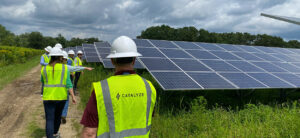3 Key Solar Energy Trends from 2023
November 13, 20232023 has been a solid year for the solar industry, marked by substantial growth and transformative developments. After a challenging start due to supply chain issues, the sector rebounded and set the stage for sustained expansion.
Explore three major solar energy trends in 2023, including industry growth, the heightened interest in community solar projects, and policies favoring continued investment in the sector.
1. Solar is Back and Bigger Than Ever
In 2022, the industry faced significant challenges as supply chains were disrupted due to the ongoing COVID-19 pandemic. Despite these setbacks, the year introduced landmark legislation – the Inflation Reduction Act – which offers new incentives like taxpayer deductions and tax credit monetization, simplifying access to solar energy for both homeowners and businesses alike.
Fast forward one year, and the future of solar energy shines brighter than ever. Over 32 gigawatts of new solar capacity is expected in 2023 – a 52% increase from 2022. While challenges remain, the solar industry is anticipated to experience sustained and strong growth in the coming years.

Catalyze launched a 6.4 MW solar farm in 2023, serving low-to-moderate income residential customers in the Buffalo Municipal Housing Authority. Over 1,300 housing units are subscribed to the Amherst solar project.
2. The Promise of Community Solar
Traditionally, solar energy installation favored real estate owners and investors, leaving renters and lower-income households without access to the benefits of solar power. Community solar, however, is reshaping the landscape, offering more Americans an opportunity to adopt and benefit from solar energy.
Community solar is a model that allows multiple individuals, businesses, or organizations to harness solar power without the need for individual panel installations. Typically, it is offered through subscription-based programs, expanding access to a wider range of customers, including renters or those without suitable rooftops. Beyond the environmental benefits, participants generally receive energy cost savings of around 10%.
Currently, 22 states have passed legislation around independent community solar projects. Despite challenges faced by states like Massachusetts and Maine in 2022, recent favorable policies in Maryland, New Jersey, and California have spurred growth. Projections indicate an annual average increase of 8% with an estimated 14 gigawatts of capacity by 2028. The U.S. Energy Department forecasts community solar powering 5 million households by 2025, making clean, affordable electricity more accessible to all.

In 2023, Catalyze launched the Sheep Creek Community Solar Farm in Adelanto, California – the state’s first solar project under California’s Enhanced Community Renewables (ECR) program. The 3.8 MWdc project supplies clean energy to local commercial utility customers and residents.
3. New Policies Favor Renewable Energy Industry
The aging U.S. energy grid, designed nearly a century ago, grapples with the strain of climate-induced events like fires and hurricanes, as well as increased demand from technologies like electric vehicles. To power the future, substantial investments are being made to create a more resilient, smart, and eco-friendly electrical infrastructure.
In October 2023, the White House unveiled a historic $3.5 billion investment in grants dedicated to energy grid projects. This landmark investment will fund 58 projects, ushering over 35 gigawatts of renewable energy onto the grid and backing over 400 microgrids.
These policy decisions not only promote the growth of the renewable energy sector but also drive job creation. Over the past decade, jobs in the solar energy industry have surged by over 167%, with over 255,000 workers in the field. The growth rate of solar jobs is projected to outpace overall job growth in the U.S. by a factor of five.
In addition, the official launch of the Climate Corps in September signifies a substantial commitment to solar technology. This training program aims to prepare younger workers for a career in clean energy and has already garnered over 42,000 signups.

Solar Energy Trends in 2023: A Bright Future
Between a record growth in solar capacity, favorable policies, and increased interest in solar energy, 2023 bucked the trends of the previous year and confirmed that renewable energy deployment is bigger than ever. As we enter 2024, what can we expect from the new year?
- Easing Supply Chain Strain – Supply chain issues continued to be strained by the passage of the Uyghur Act, which bans imported goods from the Xinjiang region of China. This has prevented hundreds of megawatts of solar panels from entering the United States and slowed solar deployment in previous years. In response, domestic manufacturing has ramped up and is anticipated to be strong in the coming years.
- Increased Value in Solar Energy Storage – To create a truly sustainable grid, solar batteries will need to be deployed more frequently and more often. Because solar panels can only operate during the day, capturing this energy for peak energy use during the evening hours is key to building reliable and decentralized power systems.
- Growing Interest in Community Solar – While interest in solar energy is at an all-time high, new paths to access must be created in order to make affordable energy accessible to all. The development of community solar projects is expected to grow significantly.
Catalyze is on the front lines of ensuring that more Americans can access clean, renewable energy. We develop, build, finance, own, and operate renewable energy assets on real estate, acting as long-term tenants on properties. Our ability to finance projects allows property owners to avoid costly upfront capital expenditures, helping more people access the financial and operational benefits of solar. Reach out to our team to learn more about our services.

